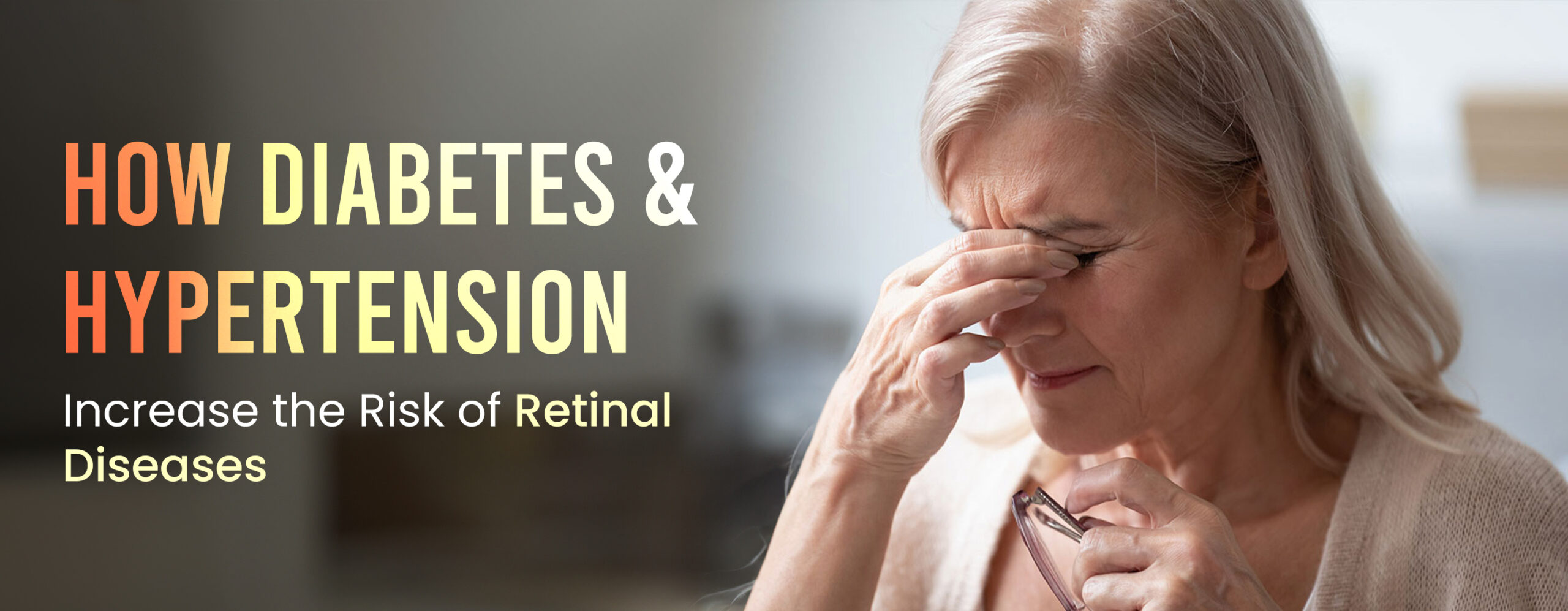
-
 Posted By shubham dhyani
Posted By shubham dhyani -
-
Comments 0
The eyes are one of the most important parts of the body, but for people with diabetes and high blood pressure (hypertension), their eyes can be at risk. These two common health problems don’t just affect blood sugar or pressure; they can quietly damage the retina, the back of the eye that helps us see clearly.
Diabetes can damage the tiny blood vessels in the retina, while high blood pressure can narrow or even break these vessels. If left untreated, these changes can cause vision loss. This blog will explain how diabetes and eye health connect, what risks hypertension and retinal disease have, and how diabetes causes vision problems. After reading this guide, you can take steps to protect your eye health and learn about a retina specialist in Delhi.
Understanding how diabetes causes vision problems
Diabetes can quietly damage the eyes without causing early warning signs. One of the main concerns is a condition called diabetic retinopathy. This happens when high blood sugar harms the small blood vessels in the retina, the part of the eye that senses light. Over time, these vessels may swell, leak fluid, or even close off, stopping blood from reaching the retina properly.
As the damage increases, new, weak blood vessels may grow, which can rupture and cause more vision problems. People with diabetes may also develop swelling in the retina’s centre, called macular oedema, which blurs vision.
Diabetic eye disease is particularly insidious because many individuals do not recognise any symptoms until the damage has occurred. That’s why regular eye checks are important for early detection. Managing blood sugar levels well can slow or stop this damage and protect vision long-term.
Hypertension’s Role in Retinal Disease
High blood pressure or hypertension can harm your eyes as well as your heart and arteries. When blood pressure is too high, it puts extra strain on the tiny blood vessels in the retina. Over time, this pressure can cause these vessels to narrow, bulge or leak, reducing the oxygen and nutrients reaching important parts of the eye. This is called hypertensive retinopathy.
In its early stages, hypertensive retinopathy doesn’t always cause symptoms. But as it progresses, individuals may begin to develop blurry vision, double vision, or sudden vision loss. The severity depends on how high the blood pressure is and how long it’s been uncontrolled. The good news is that managing blood pressure well can reduce the risk of serious eye problems.
For people who have both hypertension and diabetes, the risk to the retina is even greater. High blood pressure accelerates the damage diabetes causes and increases the risk of vision loss.
Recognising Symptoms and Early Signs
Both diabetic retinopathy and hypertensive retinopathy can develop quietly without obvious symptoms at first. Catching warning signs early is essential for protecting vision.
Common early symptoms include:
- Blurred or patchy vision
- Seeing floaters or dark spots
- Difficulty reading or seeing fine details
- Double vision or occasional eye discomfort
As the conditions progress, symptoms may become more noticeable, such as:
- Sudden flashes of light or a curtain blocking vision
- Increased difficulty focusing or seeing at night
- Distorted or hazy vision
Because early stages often have no symptoms, regular eye exams are crucial. If you have diabetes or high blood pressure, you should visit an eye doctor timely manner. Early detection can stop or prevent vision loss. Knowing these subtle changes and acting fast can make all the difference in healthy eyes.
Prevention, Monitoring, and Treatment
Taking care of your eyes starts with prevention.
- Have a balanced diet, do exercises, and take medications to maintain your blood pressure and sugar levels. Managing them well can protect the retina and help keep vision strong.
- Regular eye checks can help you detect any early-stage retina problems before symptoms appear, that why keeping a timely eye check-up routine can make a big difference in stopping vision loss later.
- Treatments like laser therapy or injections can help slow the damage to blood vessels or stop the growth of harmful new vessels in the eye.
In summary, combining good overall health habits, healthy diets and routine eye care, you can stand against the retinal risks caused by these two diseases.
Related Read: The Link Between Diabetes and Eye Health: How to Prevent Vision Loss
Summary
To protect your eyesight from diseases such as diabetes or high blood pressure, it is important to be aware, get regular examinations and maintain healthy habits. Each of these diseases presents significant risk factors to the retina; thankfully, many of these conditions can be managed with early diagnosis and care.
Make it a priority to control blood sugar and blood pressure levels through lifestyle changes and medications. Always look for expert’s advice. If treatment is needed, new laser treatment can easily slow disease progression and protect your eyesight.
For expert eye care advise and latest treatment, contact AK Institute of Ophthalmology (AKIO) in Delhi. Led by internationally acclaimed specialists like Padmashri Dr Atul Kumar and Dr Aman Kumar, AKIO offers advanced retinal and cataract care with state-of-the-art technology. Their team combines gentle care with the latest surgical techniques to protect and restore vision.
Book a consultation with AKIO to get personalised, world-class eye care and take the best step toward safeguarding your eyesight for years to come.
Don’t wait for symptoms to worsen. Book a Consultation call with a trusted retina specialist at AKIO today and take the first step toward clearer, healthier vision.
Recent Posts
- Why You Need a Retina Specialist for Cataract Surgery – Cataract + Retina Issues Together
- Retina Injections (Anti-VEGF): Procedure, Cost, Effectiveness, Risk & Recovery Experience
- Early Signs of Retinal Detachment You Should Never Ignore
- Floaters vs Retina Detachment – How to Know the Difference?
- Manage Your Retina Conditions: Simple Healthy Habits for Better Vision



